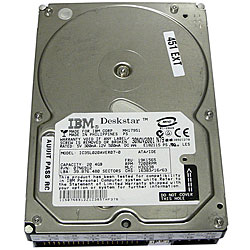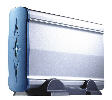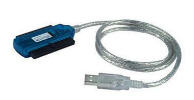Another deathstar bites the dust!
 A few days ago I had some good news to report: my faulty power button was finally replaced with a shiny new example. Skip forwards a few days, and today's news is not so good: the second hard drive of that very same computer refuses to work any longer.
A few days ago I had some good news to report: my faulty power button was finally replaced with a shiny new example. Skip forwards a few days, and today's news is not so good: the second hard drive of that very same computer refuses to work any longer.
When I first put in the hard drive, an IBM Deskstar of 40Gb, it already refused to cooperate with the Samsung master drive, and it took me a long time to get both devices to become friends with eachother. They've been working for several years now, so I assumed it would be no big problem to get the IBM going again...
Unfortunately, I was wrong. After trying every possible combination of both drives with both IDE channels, I started trying to add the IBM drive as a single drive to my computer. During that time, I heard a rather disturbing noise coming from the hard drive, the last few times I tried to boot my computer.
For those who haven't heard about it: the IBM Deskstar had an awful reputation back in the days, resulting in it to become known as the IBM "Deathstar". Most of the drives failed, and failed horribly, in one way or the other. Sometimes there was a problem with the logical board, other times with the platters or the heads.
Having had the good fortune that my drive already lasted for such a long time, I started to consider this to be a rescue operation.
So if you're looking for a way to revive a dead hard drive, here are some tips you could try (in order of sanity):

1. Bring out the External enclosure!
Since my hard drive wasn't recognised any longer by the BIOS, I had to find another way to access it. The benefit of an external enclosure is the fact that they (mostly) access the drive in another way than your computer does via its IDE channel. They also tend to ignore master/slave jumper settings. It's worth a shot, but connected via USB the speed for data retrieval is a lot lower than that of a default IDE cable.

2. USB-to-IDE is the key!
Basically this is the same setup as an external enclosure, but without the enclosure. Chances that this setup will work, whereas the enclosure doesn't, are slim - yet existing. So when I still couldn't access the data on the drive, I grabbed the opportunity to test this connection as well. Still no luck, though...
3. Ice, ice, baby!
By now I had given up on my hard drive. Since most of the stuff on it was already backed up somewhere, I figured I could try some more extreme ways of getting it to work.
 One of the common suggestions heard on the internet is to put the drive in the freezer for a while. This is supposed to give the headers a chance to reposition themselves over the platters.
One of the common suggestions heard on the internet is to put the drive in the freezer for a while. This is supposed to give the headers a chance to reposition themselves over the platters.
I could hear the drive spinning up on boot, but it sort of stopped prior to reaching full speed, so I decided to try the freezer method. Exactly one hour later, I hooked up my drive to the USB-to-IDE chain again, and voila! The drive spun up to its normal speed, and I no longer heard the so-called "click of death" noise. Alas, I still could not detect the hard drive via USB.

4. The Neanderthal way of fixing things...
Last but not least, I've heard somewhere that it's possible to restore a dead drive by giving it a loud tap, while spinning, right on the axis of the platter motor. It speaks for itself that, despite the thumbnail, you should NOT do this with a hammer. Having tried all other options, I figured I'd give this a try as well: nothing was broken while doing so, but nothing was fixed either (as expected).
The result: 40Gb of presse-papier
In the end I had to face the facts and give up: I now have a pretty, shiny, 40Gb presse-papier wandering around on my desk, holding its data locked inside for ages to come.
So if you find yourself in the same position as me, give the above options a try, maybe they work for you. However, if the data on your drive is of any value, do NOT try the last two options since they could kill whatever's left of your drive. There are plenty of data recovery firms out there who can and will retrieve your data - but at a cost.
Whatever the outcome, the moral of the story still seems to be the same: backup often!